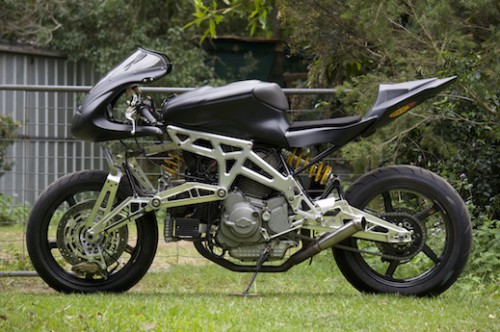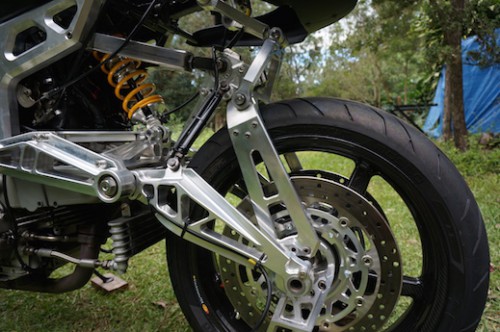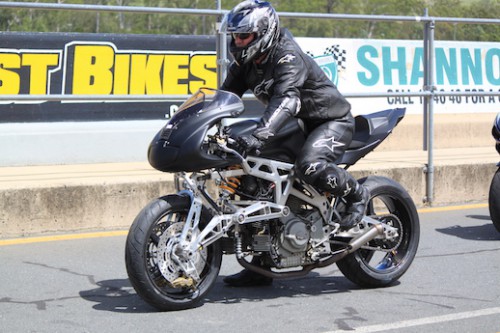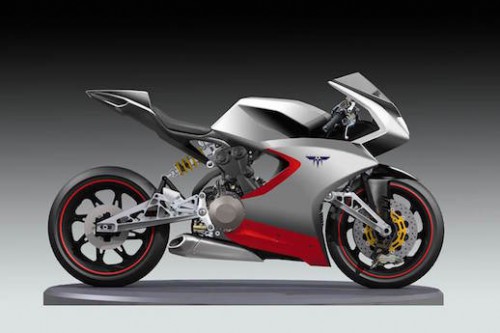Film animator and motorcycle enthusiast Ray Van Steenwyk invented a revolutionary steering and suspension system claimed to make riding safer. The new, purely triangulated steering and suspension system creates ultimate stability for the front end of a motorcycle. The new suspension system debuted in the Motoinno TS3 patented prototype that is powered by a Ducati 900 SS engine.

Motoinno TS3
Ray is a film animator (his last work was the toxic storm scene in the new “Mad Max 4: Fury Road” movie) and self-taught engineer who lives near Brisbane in Australia. He began restoring motorcycles two decades ago and as he noticed the differences between the types of steering systems, he came up with new ideas and started to develop a brand new steering and suspension system.
“Previous centre steering systems have had inherent problems,” he says. “There is a lack of corner ground clearance, they look awful and their many associated steering linkages make their steering input vulnerable to inconsistent and sloppy front-end feel.”

The TS3′s triangular steering system
See this Master Titanium Fork Lock for Motorcycle Steering Neck and Loop (C01052470)
He began working on the new system in 1997 and his company has just recently patented the result. The system separates steering and suspension from braking while creating a stronger, more compliant, highly adjustable, tunable, stable and safer two-wheeled in-line front end system.

The Motoinno TS3 on the track testing
Key features of the system are:
- Purely triangulated front end stability.
- Fully adjustable pro-dive and anti-dive combination capabilities between: 100% (full front end dive) / 0% (neutral front end dive geometry) / 100% (front end rise under braking). Best practice combination outcomes have already been recognised, tested and implemented within the prototype.
- Adjustable rake and trail – from 15 to 24 degrees. – known range of stability factors for a hub-centre system.
- Attains a higher rate of turn for less lean – into, during and on exiting a corner.
- Separates steering from suspension and braking.
- Can be braked harder and later into corners, including trail braking through any corner/camber combination.
- In-line and corner trail braking does not upset front end stability or bike trajectory.
- Throttle changes during cornering do not unsettle the front end stability or trajectory.
- Directional changes during a corner do not upset front end stability and overall trajectory.
- Retains a constant steering geometry under straight line, lateral and horizontal bump suspension braking and forward acceleration.
- Suspension does not collapse (bottom out) under heavy or emergency stop braking.
- Virtual king-pin from the tyre contact patch (tyre braking point) to the top of the wheel along the steering axis.
- Has no corner lean clearance issues inherent in other alternate or HCS designs.
- Carries loads many hundreds of times its own weight with increased stability.
- No in-corner lateral bump flex harmonics under corner braking.
- No horizontal bump or stop flex harmonics on inline braking or during corner braking.
- Reduces chassis and headstock weight and lowers centre of gravity for greater stability.
- Allows a shorter wheel shock load path to the COG of the motorcycle.
- Removes unbalanced and dangerous lateral and horizontal flexibility during in-line and corner steering.
- 54 degrees of lock to lock steering compared to 38 degrees for a conventional sports bike.
- Retains a classical motorcycle appearance necessary for rider and commercial acceptance.
- Removes high stress loads on hub-centre king-pin and inherent destructive oscillation harmonics that normally unsettles the front of the motorcycle – a major cause of motorcycle accidents.

The TS3 with fairing
Ray and his company’s engineers continue to work on the final version of the TS3 that will use a water-cooled Ducati 2014 Monster 1200 Testastretta engine. They also plan to participate in the Moto2 series. “From our initial data acquisition tests, it appears we can be up to a second faster through each corner,” Ray says. “It would probably be banned after the first season, but that’s ok; it will have proved a point.”

